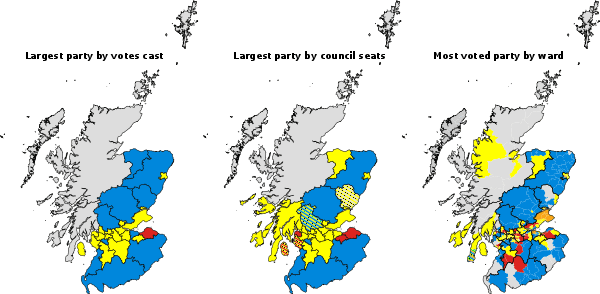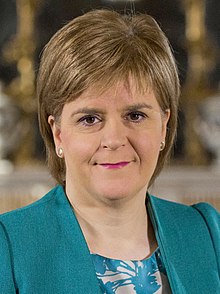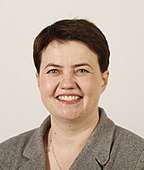2017 Scottish local elections
The 2017 Scottish local elections were held on Thursday 4 May, in all 32 local authorities. The SNP retained its position as the largest party in terms of votes and councillors, despite suffering minor losses. The Conservatives made gains and displaced Labour as the second largest party, while the Liberal Democrats suffered a net loss of councillors despite increasing their share of the vote.[4] Minor parties and independents polled well; and independent councillors retained majority control over the three island councils. For the first time since the local government reforms in 1995, all mainland councils fell under no overall control.
| |||||||||||||||||||||||||||||||||||||||||||||||||||||||||||||||||||||||
All 1,227 seats[1] to 32 Scottish councils | |||||||||||||||||||||||||||||||||||||||||||||||||||||||||||||||||||||||
|---|---|---|---|---|---|---|---|---|---|---|---|---|---|---|---|---|---|---|---|---|---|---|---|---|---|---|---|---|---|---|---|---|---|---|---|---|---|---|---|---|---|---|---|---|---|---|---|---|---|---|---|---|---|---|---|---|---|---|---|---|---|---|---|---|---|---|---|---|---|---|---|
| Turnout | 46.9% ( | ||||||||||||||||||||||||||||||||||||||||||||||||||||||||||||||||||||||
| |||||||||||||||||||||||||||||||||||||||||||||||||||||||||||||||||||||||
 Most voted for party by council, largest party by council, and largest party by ward. Ward map utilises the new ward boundaries. * Indicates boundary change - so this is a nominal figure | |||||||||||||||||||||||||||||||||||||||||||||||||||||||||||||||||||||||
Background
The previous election was in 2012. Normally these elections take place every four years, but this election was postponed for a year in order to avoid conflicting with the 2016 Scottish Parliament election.
Once again the local elections were counted electronically, using the same system used in 2012. The tender was awarded to CGI (formerly Logica) and Idox Elections (formerly Opt2vote), both of which delivered the 2012 elections successfully.
Eligibility to vote
All registered electors (British, Irish, Commonwealth and European Union citizens) who were aged 16 or over on polling day were entitled to vote in the local elections.[5][6] A person who had two homes (such as a university student who has a term-time address and lives at home during holidays) could register to vote at both addresses as long as they are not in the same electoral area and can vote for two different councils, albeit only in two different local elections; however, it is an offence to vote twice in the same type of election and doing so may incur a fine of up to £5,000.[7]
Individuals must have registered to vote by midnight twelve working days before polling day (17 April 2017).[8] Anyone who qualified as an anonymous elector had until midnight on 25 April 2017 to register.[9]
Party performance
Following the election, SNP leader Nicola Sturgeon played down the threat posed by the Conservatives to her party, asserting that the good performance by the Conservatives was on account of Labour support going to the Conservatives and not because of any shift in SNP voters.[10]
Scottish Conservative leader Ruth Davidson asserted a "Scottish fightback against the SNP" and said that the results represented a resurgence for the Scottish Conservatives despite the fact that the SNP's 1st preference vote percentage had not changed since the 2012 election.[11]
Scottish Labour leader Kezia Dugdale admitted the results were disappointing for her party, while the Scottish Liberal Democrats leader Willie Rennie said the council results showed his party could stand against the SNP tide in key northern constituencies.[12]
Aftermath
Aberdeenshire
The Scottish Conservatives returned the most councillors, the first time it has been the largest party in the region since the 1982 election, when the area was under the Grampian Regional Council, although they were stopped short of an overall majority. The number of Scottish National Party councillors fell by a quarter but remained the second largest group. The Scottish Liberal Democrats picked up a couple of seats while the other parties gained roughly the same results as the previous election.
On 18 May, the Conservatives, Liberal Democrats and Aligned Independents formed an administration, with Jim Gifford (Conservative) elected as council leader and Bill Howatson (Liberal) was made Provost.[13]
Argyll and Bute
The SNP became the largest party on the council for the first time, as the Independent group lost a third of its seats compared to the previous election. The Conservatives gained five seats and the Liberal Democrats gained two, but both remained in their respective places as the two smaller parties.
Despite the SNP's position, a coalition was formed of Conservatives, Liberal Democrats and Independents, referred to as The Argyll Lomond and the Isles Group (TALIG). Aileen Morton, leader of the group, was elected as council leader.[14]
Fife
The Scottish National Party replaced Scottish Labour as the largest party for the first time in the Fife region, although they did not gain enough seats to form a majority. The Scottish Conservatives made the most gains, replacing the Scottish Liberal Democrats as the third biggest party. The election also returned no Independent councillors, marking the first time the area will be without any Independent representation since the creation of Fife Regional Council in 1974.
On 18 May, the two largest parties of the new council, the SNP and Scottish Labour, signed a Power Sharing Agreement to co-run an administration. David Alexander (SNP) and David Ross (Labour) were made co-leaders, and Jim Leishman remained in his role as Provost.[15]
Glasgow
The SNP replaced Labour as the biggest party; although without a majority it ended Labour's 37-year-long control of the council.[16] The Conservatives increased its number of councillors from 1 to 8, their highest since 1984, while the Scottish Green Party also made a couple of gains to reach their highest ever level in Glasgow. This council is the first without any Liberal representation since 1974.
The SNP took control of the council as a minority administration with SNP members filling the positions of council leader, depute council leader, and Lord Provost.[17]
Councils
| Council | 2012 Result: Largest party (Parties in control) |
Control before election (Change in control since May 2012, if different) |
2017 Result: Largest party (Parties in control)[3][18] |
Details | |||
|---|---|---|---|---|---|---|---|
| Aberdeen City | Labour (Lab + Con + Ind) | SNP (Con + Lab)[19] | Details | ||||
| Aberdeenshire | SNP (Con + LD + Ind) | SNP (SNP + Lab + Ind) | Conservative (Con + LD + Ind)[20] | Details | |||
| Angus | SNP (SNP majority) | SNP (SNP minority) | SNP / Independents tie (Ind + Con + LD) | Details | |||
| Argyll and Bute | Independent (Ind + SNP) | Independent (Ind + Con + LD) | SNP (Ind + Con + LD) | Details | |||
| Clackmannanshire | SNP (SNP minority) | SNP (SNP minority) | Details | ||||
| Dumfries and Galloway | Labour (Con + SNP) | Labour (Lab minority) | Conservative (Lab + SNP)[21] | Details | |||
| Dundee City | SNP (SNP majority) | SNP (SNP + Ind)[22] | Details | ||||
| East Ayrshire | SNP (SNP + Con) | SNP (SNP minority) | Details | ||||
| East Dunbartonshire | SNP (Lab + LD + Con) | Labour (Lab + Con minority) | SNP (Con + LD) | Details | |||
| East Lothian | Labour (Lab + Con) | Labour (Lab minority)[23] | Details | ||||
| East Renfrewshire | Labour (Lab + SNP + Ind) | Conservative (Lab + SNP) | Details | ||||
| City of Edinburgh | Labour (Lab + SNP) | SNP (Lab + SNP)[24] | Details | ||||
| Falkirk | Labour (Lab + Con + Ind) | SNP (SNP + Ind minority)[25] | Details | ||||
| Fife | Labour (Lab minority) | SNP (Lab + SNP)[15] | Details | ||||
| Glasgow City | Labour (Lab majority) | SNP (SNP minority) | Details | ||||
| Highland | Independent (SNP + LD + Lab) | Independent (Ind minority) | Independent (Ind + LD + Lab)[26] | Details | |||
| Inverclyde | Labour (Lab w/ Ind + Con support) | Labour (Lab minority) | Details | ||||
| Midlothian Council | Labour (SNP + Green + Ind) | Labour (Lab minority) | Details | ||||
| Moray | SNP (Ind + Con) | SNP (Con + Ind) | Details | ||||
| Na h-Eileanan Siar | Independent | Independent | Details | ||||
| North Ayrshire | SNP (SNP minority) | Labour (Lab minority) | Labour / SNP tie (Lab minority) | Details | |||
| North Lanarkshire | Labour (Lab majority) | SNP (Lab minority) | Details | ||||
| Orkney | Independent | Independent | Details | ||||
| Perth and Kinross | SNP (SNP w/ Con support) | Conservative (Con + LD + Ind)[27][28] | Details | ||||
| Renfrewshire | Labour (Lab majority) | SNP (SNP minority) | Details | ||||
| Scottish Borders | Conservative (SNP + Ind + LD) | Conservative (Con + Ind)[29] | Details | ||||
| Shetland | Independent | Independent | Details | ||||
| South Ayrshire | Conservative (Con w/ Lab + Ind support) | Conservative (SNP + Lab + Ind)[30] | Details | ||||
| South Lanarkshire | Labour (Lab + LD + Con) | Labour (Lab majority) | SNP (SNP minority)[31] | Details | |||
| Stirling | SNP (Lab + Con) | Conservative / SNP tie (Lab + SNP) | Details | ||||
| West Dunbartonshire | Labour (Lab majority) | SNP (SNP + Ind minority)[32] | Details | ||||
| West Lothian | Labour (Lab w/ Con + Ind support) | SNP (Lab w/ Con support) | Details | ||||
Opinion polling
| Date(s) conducted |
Polling organisation/client | Sample size | SNP | Lab | Con | Lib Dem | Green | UKIP | Others | Lead |
|---|---|---|---|---|---|---|---|---|---|---|
| 24 Feb–6 Mar 2017 | Ipsos MORI/STV | 1,029 | 46% | 17% | 19% | 6% | 8% | 3% | <1% | 27% |
| 7–13 Feb 2017 | Panelbase/Wings Over Scotland | 1,028 | 47% | 14% | 26% | 5% | 4% | 3% | <1% | 21% |
| 3 May 2012 | 2012 Election Results | 1,556,773 | 32.3% | 31.4% | 13.3% | 6.6% | 2.3% | 0.3% | 13.8% | 0.9% |
Results
Summary of the 4 May 2017 Scottish council election results[33][34]
| Party | First-preference votes | Councils | +/- | 2012 seats | 2017 seats | Seat change | ||||||
|---|---|---|---|---|---|---|---|---|---|---|---|---|
| Seats won | Notional | Seats won | Seat % | vs Notional | ||||||||
| Scottish National Party | 610,454 | 32.3% | 0 | 425 | 438 | 431 | 35.1% | |||||
| Conservative | 478,073 | 25.3% | 0 | 115 | 112 | 276 | 22.5% | |||||
| Labour | 380,957 | 20.2% | 0 | 394 | 395 | 262 | 21.4% | |||||
| Independents | 196,438 | 10.4% | 3 | 196 | 198 | 168 | 14.1% | |||||
| Liberal Democrats | 130,243 | 6.9% | 0 | 71 | 70 | 67 | 5.5% | |||||
| Green | 77,682 | 4.1% | 0 | 14 | 14 | 19 | 1.6% | |||||
| Orkney Manifesto Group | 894 | 0.0% | 0 | 2 | 0.1% | New | ||||||
| West Dunbartonshire Community | 2,413 | 0.1% | 0 | 1 | 0.1% | New | ||||||
| The Rubbish Party | 784 | 0.0% | 0 | 1 | 0.1% | New | ||||||
| UKIP | 2,920 | 0.2% | 0 | 0.0% | ||||||||
| Independent Alliance North Lanarkshire | 2,823 | 0.2% | 0 | 0.0% | ||||||||
| TUSC | 1,403 | 0.1% | 0 | 0.0% | ||||||||
| A Better Britain – Unionist Party | 1,196 | 0.1% | 0 | 0.0% | ||||||||
| Scottish Socialist | 928 | 0.0% | 0 | 1 | 0 | 0.0% | ||||||
| Solidarity | 883 | 0.0% | 0 | 0.0% | ||||||||
| Libertarian | 776 | 0.0% | 0 | 0.0% | ||||||||
| RISE | 186 | 0.0% | 0 | 0.0% | ||||||||
| Scottish Independent Network | 145 | 0.0% | 0 | 0.0% | ||||||||
| Scottish Unionist | 129 | 0.0% | 0 | 0.0% | ||||||||
| Social Democratic | 112 | 0.0% | 0 | 0.0% | ||||||||
| Scottish Christian | 104 | 0.0% | 0 | 0.0% | ||||||||
| Socialist Labour | 76 | 0.0% | 0 | 0.0% | ||||||||
| National Front | 39 | 0.0% | 0 | 0.0% | ||||||||
| No Overall Control | — | — | — | 29 | — | — | — | — | — | |||
| Total | 1,889,658 | 100.0 | ±0.0 | 32 | 1,223 | 1,227 | 1,227 | 100.00 | ||||
The table has been arranged according to popular vote, not the number of seats won.
Boundary changes
Prior to the 2017 elections, changes were made to council ward boundaries in 25 council areas. This meant that comparisons with the actual results from 2012 were inaccurate due to a small increase in the total number of seats (from 1,223 to 1,227), different boundaries, and some wards having their number of councillors adjusted. These changes led BBC News, using work done by Professor David Denver of Lancaster University, to estimate what the results would have been in 2012 if the new boundaries and seat numbers had been in place for that election.[3][35]
See also
References
- http://www.lgbc-scotland.gov.uk/reviews/5th_electoral/01_resources/News_release_260516.pdf
- The "seats before" figure is a notional calculation by BBC News. These notional figures estimate what the results would have been in 2012, if the 2017 boundaries had been in place at that election, as boundary changes make direct comparison complicated.
- "Scotland Results". BBC News.
- "Report: Scottish local election results 2017". BBC News (Scotland).
- "Scottish Elections (Reduction of Voting Age) Act 2015, Section 1". Legislation.gov.uk. Retrieved 24 April 2017.
- "Representation of the People Act 1983, Section 2". Legislation.gov.uk. Retrieved 24 April 2017.
- Electoral Commission. "I have two homes. Can I register at both addresses?". electoralcommission.org.uk. The Electoral Commission. Retrieved 24 April 2017.
- "Timetable for Scottish council elections on 4 May 2017" (doc). The Electoral Commission. Retrieved 24 April 2017.
- The deadline for the receipt and determination of anonymous electoral registration applications was one working day before the publication date of the notice of alteration to the Electoral Register (that is the sixth working day before polling day). cf "Guidance for Electoral Registration Officers (Part 4 – Maintaining the register throughout the year)" (PDF). Cabinet Office and The Electoral Commission. July 2016. p. 114 (para 7.128). Retrieved 24 April 2017.
- "Local elections: Sturgeon plays down Tory success in Scotland". PA. Guardian.
- Johnson, Simon. "Ruth Davidson hails 'fightback' after Scottish Tory council surge and voter backlash against indy ref". Telegraph.
- McKiernan, Jennifer (6 May 2017). "Local Elections 2017: Party leaders react to results". The Press and Journal.
- "Aberdeenshire council chief hails authority for getting job done without any 'political spats' - Evening Express". Evening Express. Retrieved 20 May 2017.
- "Economic growth and education priorities in Argyll | Press and Journal". Press and Journal. Retrieved 20 May 2017.
- "Fife Council agree to SNP and Labour joint partnership". Dunfermline Press. Retrieved 20 May 2017.
- "SNP replaces Labour as largest party in Glasgow". BBC News. 5 May 2017.
- "Councillor Eva Bolander chosen as Glasgow's Lord Provost". Glasgow City Council. 18 May 2017. Retrieved 20 May 2017.
- "List of council administrations". BBC News.
- "Scottish Labour councillors on Aberdeen City Council suspended". Holyrood Website. October 3, 2019.
- "70 councillors elected to form new Aberdeenshire Council - Aberdeenshire Council". online.aberdeenshire.gov.uk.
- Reid, Fiona (23 May 2017). "Elaine is new leader". DnG24 Media.
- "SNP to form administration with Independent on Dundee City Council". BBC News. 12 May 2017. Retrieved 15 May 2017.
- Sharp, Marie (10 May 2017). "Labour set to go it alone on East Lothian Council". Retrieved 15 May 2017.
- "City of Edinburgh Council to be run by coalition". 15 June 2017. Retrieved 15 June 2017.
- "SNP minority takes control of Falkirk Council". 17 May 2017. Retrieved 19 May 2017.
- "Independent, Lib Dem, Labour coalition to run Highland". BBC News. 10 May 2017. Retrieved 10 May 2017.
- Foote, Chris (15 May 2017). "Tory-led coalition takes over Perth and Kinross from SNP". STV News. Retrieved 15 May 2017.
- Buchan, Jamie (16 May 2017). "EXCLUSIVE: Split at Perth and Kinross coalition, just hours after launch". The Courier. Retrieved 16 May 2017.
- "Conservatives and independents to run Scottish Borders Council". BBC News South Scotland. BBC News. 9 May 2017. Retrieved 9 May 2017.
- "SNP, Labour and Independent councillors to run South Ayrshire Council". BBC News. 11 May 2017. Retrieved 12 May 2017.
- Dickie, Douglas (10 May 2017). "SNP set to run minority administration at South Lanarkshire Council". Daily Record. Retrieved 16 May 2017.
- Foulds, Jenny (18 May 2017). "New West Dunbartonshire Council administration revealed". Daily Record. Retrieved 18 May 2017.
- "Full council election results published". May 8, 2017 – via www.bbc.co.uk.
- "ElectionsScotland: SLGE2017 Summary Results Data".
- "How the BBC calculates local election results". 2017-05-09. Retrieved 10 May 2017.


.jpg)